Mastering the Art of Plating Grilled Fish: Elevate Your Presentation
Jun 10,2016
Mastering the Art of Plating Grilled Fish: Elevate Your Presentation
Jun 10,2016
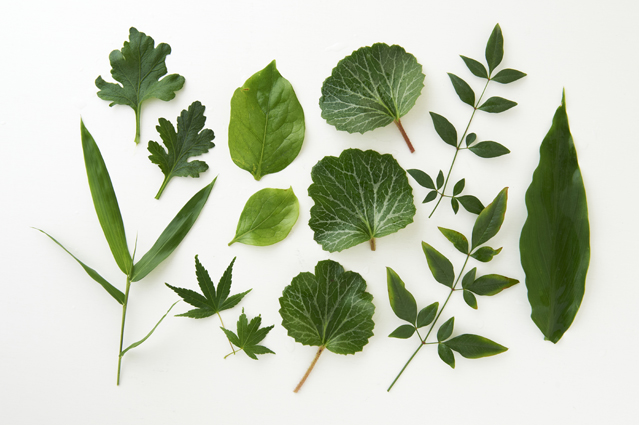
Grilled fish is commonly eaten in the home and at restaurants in Japan. But because it’s such a familiar dish, people are seldom aware of the elaborate rules governing how it’s to be served. Culinary expert Kubo Kanako walks us through the Japanese art of plating grilled fish.
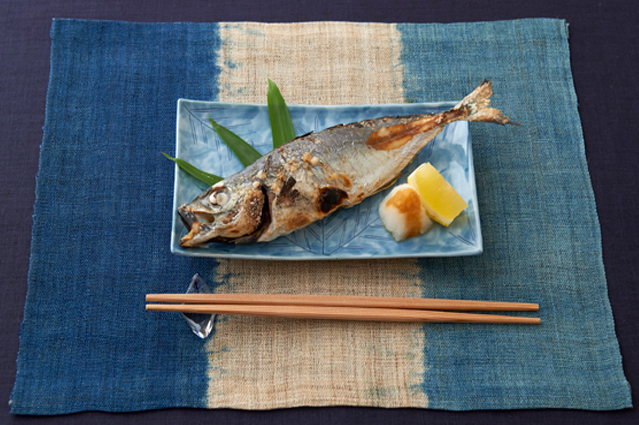
Grilled fish is standard fare at restaurants and homes in Japan. But have you ever carefully observed how it’s presented? First we asked Kanako about the basics of plating fish.
“When plating grilled fish, there are rules governing which way the fish faces and the placement of the garnish. If the head is still on the fish, it should point left with the underside of the fish facing you. The trick is to make the fish look like it’s swimming on the plate. What’s called a kaishiki or ‘bed’ is placed under the fish. This can be a sasa bamboo leaf, for example, which when placed on the plate at a slight angle adds a dash of color and makes for an eye-pleasing design. Grilled fish is commonly accompanied by a slice of sudachi citrus or lemon or grated daikon. This is called the ashiraimono or ‘garnish,’ and it’s always placed in front of the fish on the right-hand side. That’s the rule in Japanese cuisine.”
Making the fish look like it’s actually swimming is a very Japanese touch. At restaurants, fish is often served grilled on a skewer with the body twisting and turning to create a three-dimensional effect. This too is intended to suggest a fish swimming. Another trick used to make the fish look attractive is sprinkling the tail fin, pectoral fin, and dorsal fin with salt to prevent charring.
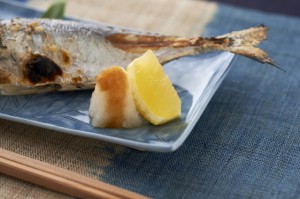
For a pleasing look, form the grated daikon into a mound, with a sudachi or lemon slice to the right.
“With steak and other Western dishes, trimmings like broccoli and potatoes are typically placed at the back of the plate,” says Kanako. “People are so used to seeing that arrangement that they tend to confuse it with how Japanese cuisine is plated. But when serving grilled fish Japanese style, remember that the basic rule is to place the garnish in front to the right.” Knowing the steps for plating a fish makes it easy to serve a visually pleasing meal.
“Have fun by varying the garnish you use by the season. Citrus fruit, for example, is a commonly used garnish. Well, you can serve the fish with whatever citrus fruit is in season: yuzu, kabosu, lemon, shekwasha (flat lemon), or whatever.”
< Steps in plating a fish >
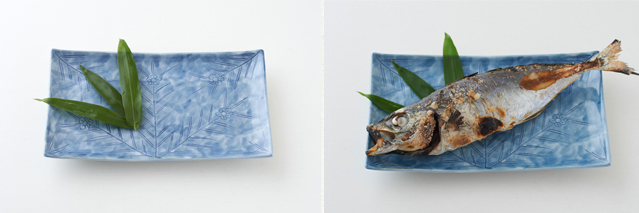
First, place a sasa bamboo leaf at the rear left of the plate as a kaishiki (bed).
Then position the fish with the head at the front left, the tail at the rear right, and the underside facing forward. The trick is to leave some open space in front to the right. Placing the fish at an angle creates a less cluttered, more attractive look.
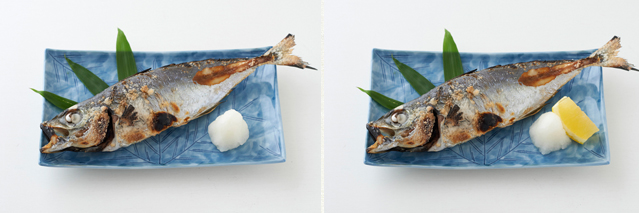
Place some grated daikon in a small conical mound in front to the right of the fish. The ashiraimono (garnish) should always come in front to the right. Lean a lemon slice against the grated daikon.
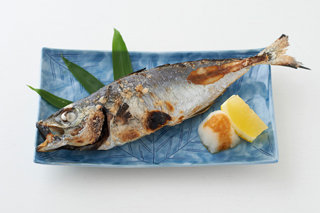
Finally, add soy sauce to the grated radish to make what is called someoroshi or “dyed grated radish.” This finishing touch should be left until immediately before serving.
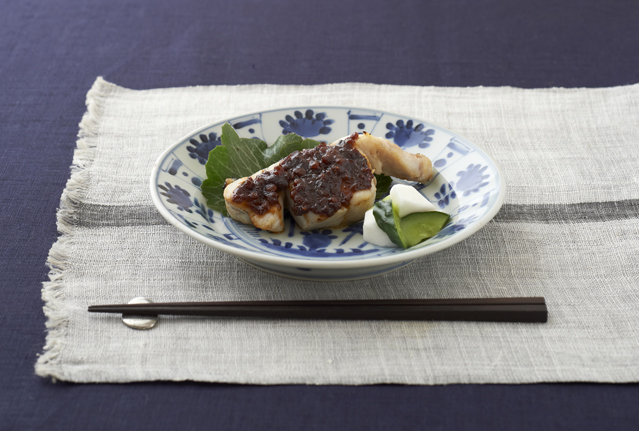
We asked Kanako what an ashiraimono or garnish is for in the first place. “In Japanese cuisine, an ashiraimono is something to refresh the mouth,” she explains. “It also has antitoxic properties and serves to stimulate the appetite.” Grated daikon is sometimes consumed with the fish itself, but other types of ashiraimono are eaten between mouthfuls of fish.
“If the grilled fish is salted, it’s typically garnished with grated radish and a citrus fruit such as sudachi. Foods flavored with soy sauce like tsukudani also go perfectly with salted fish, as does anything miso-flavored. So too do sour-tasting foods, including sweet vinegar pickles. Fish grilled with miso can be garnished with vegetables preserved in salt or rice bran. Teriyaki can be garnished with grated radish. Garnishing the fish with an ashiraimono that has a contrasting flavor makes it more delicious. You want to avoid anything that duplicates the flavor. You wouldn’t garnish salted fish with something pickled in salt, say, or teriyaki with tsukudani.”
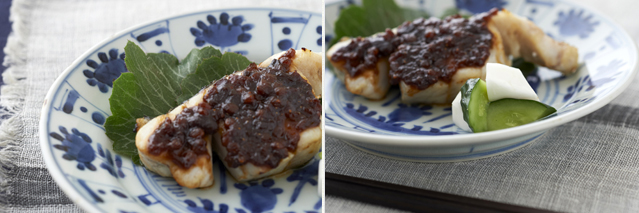
Left: The leaf of the strawberry saxifrage, a common Japanese garden plant, used as a kaishiki under the fish.
Right: Grilled fish marinated in moromi (unrefined soy sauce) goes perfectly with pickles .
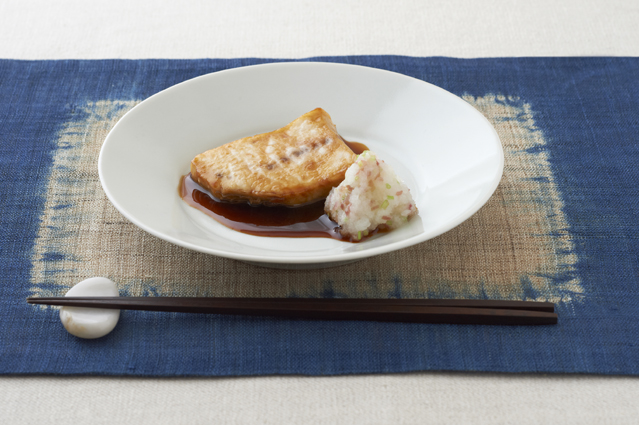
The crisp, clean taste of grated daikon nicely complements teriyaki.
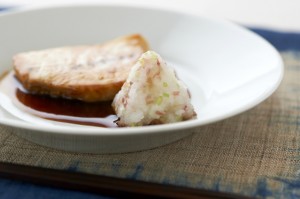
To make your everyday grated daikon look more exciting and artistic, mix it with myoga (Japanese ginger) and mitsuba (Japanese wild parsley) stems, both finely chopped.
“Getting a bit creative with the kaishiki you place under the fish and the ashiraimono you garnish it with is all you need to do to create a different visual impression,” Kanako notes.
“By using a different type of leaf for the kaishiki—sasa bamboo or nandina, say, or myoga or strawberry saxifrage or maple—or by tweaking the garnish, you can turn an ordinary grilled fish dish into something fresh and exciting. When you eat grilled fish at a Japanese restaurant, it’s interesting to observe what the chef has paid particular attention to in plating it.”
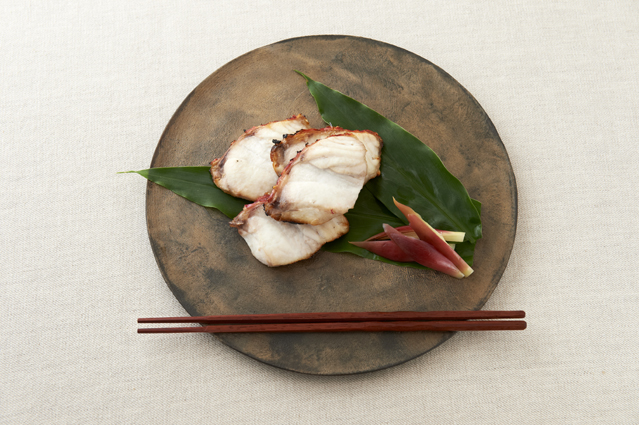
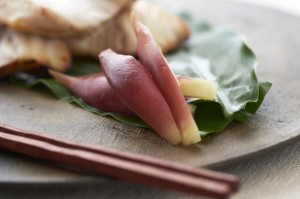
Salted and grilled onagadai (longtail red snapper) on a bed of myoga leaves, garnished with myoga pickled in sweet vinegar. Soaking the leaves used for the kaishiki in water until immediately before plating gives them a beautifully fresh appearance. Myoga pickled in sweet vinegar goes well with many different types of grilled fish. It jazzes up the plate with its bright, vibrant color.


Serving the same grilled onagadai with maple leaves and tsukudani creates a completely different impression. Other suitable garnishes include red turnip pickled in vinegar and pickled Japanese scallions.
“If you’re cooking at home, you don’t need to go out of your way to track down some sasa bamboo or strawberry saxifrage leaves. You can substitute ordinary kitchen vegetables like komatsuna (Japanese mustard spinach) or baby greens. Just try using similar-sized vegetables as trimmings: mitsuba in place of maple leaves, say, or turnip leaves in place of myoga leaves. Some green will add a nice dash of color to the plate and make the fish look that much more appetizing.”
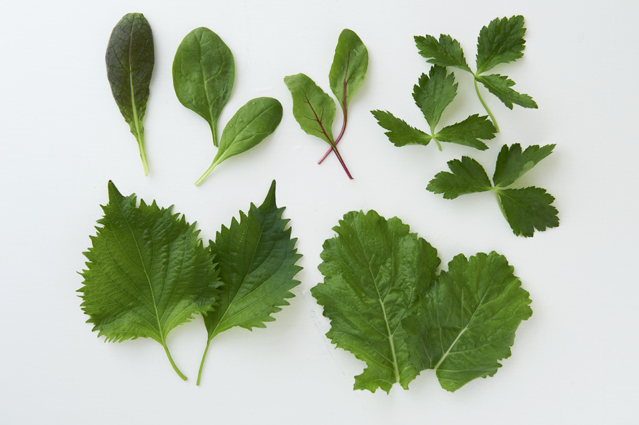
Leaves easily available for using as kaishiki in the home. Clockwise from lower left: perilla, baby greens, mitsuba, turnip leaves. While many different types of leaves can be used for kaishiki, anything that has a strong aroma or exudes sap should be avoided. Remember also that some wild plants are poisonous, so be on the safe side. Stick with plants you’re familiar with or ordinary vegetables, Kanako advises.
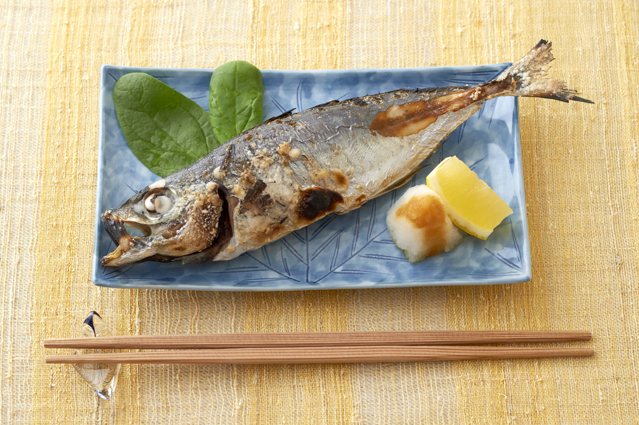
Bok choy used as a kaishiki bed in place of sasa bamboo leaves.
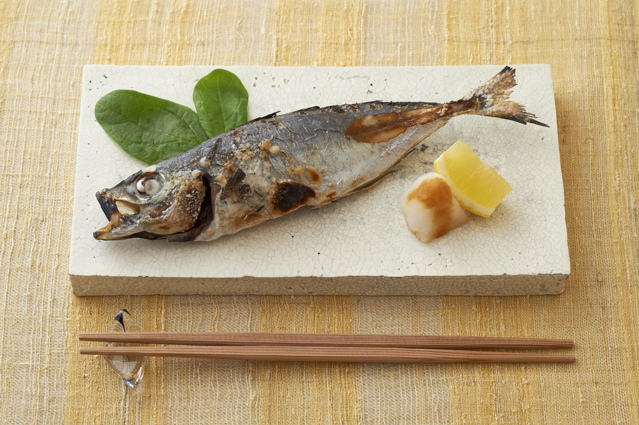
Serving the fish on a larger plate creates a more elegant impression, even if it’s identically arranged. As you master the basics, you can try using different plates to match the occasion.
In this installment, Kanako has offered tips on how to turn an everyday dish of grilled fish into something new and exciting, just by adding a few twists. We hope you’ll have fun experimenting with different kaishiki beds and ashiraimono garnishes in your own kitchen.
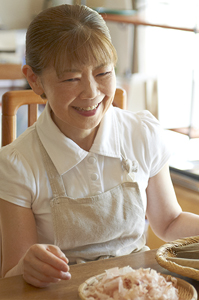
Culinary Researcher
Culinary Researcher
Growing increasingly interested in cooking, Kubo Kanako studied at the long-established Kyoto ryotei (high-class Japanese restaurant) Tankuma Kitamise from the time she was a high school student. After graduating from the Department of English at Doshisha University, she entered the Tsuji Culinary Institute, where she obtained chef’s and fugu (puffer fish) cooking licenses. Following a stint in the Tsuji Culinary Institute’s publications arm, she edited cook books at a publishing house in Tokyo, before going independent.
Today, Kubo is actively involved in a variety of culinary-related endeavors, including culinary production, styling, restaurant menu development, table decorating, editing and more.
She is the author of several works in Japanese, including Utsukushii morituske no kihon [Basics of Beautiful Plating] (Seibido Shuppan), Utsukushii ichiju nisai: “Oishii” to “kirei” in ha wake ga aru [Beautiful Soup and Two Dishes: There are Reasons for “Deliciousness” and “Beauty”] (Kawade Shobo Shinsha), Kichinto, yasai no kobachi chotto shita kotsu de “mō ippin” ga gutto oishikunaru! [Small Vegetable Side Dishes: Little Tips that Make That Extra Something So Much More Delicious] (Kawade Shobo Shinsha), Kichinto, oishii mukashinagara no ryōri [Delicious Old-Time Cooking] and Shun no aji techō aki to fuyu [Seasonal Flavor Handbook: Fall and Winter] (both Seibido Shuppan)